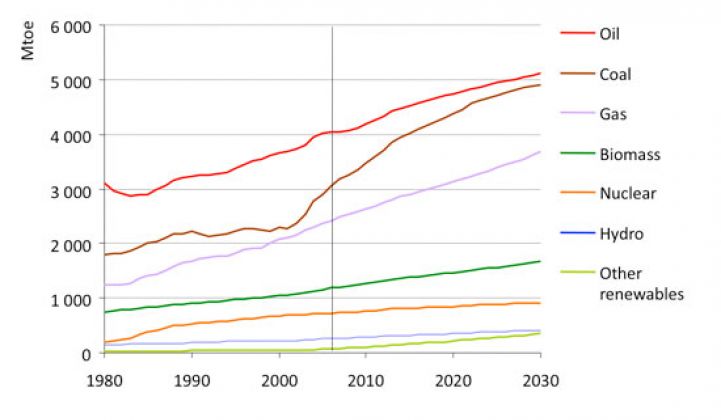The International Energy Agency (IEA) released its annual report today, and it predicts we're in a heap of trouble, people.
The world will need to invest $26.3 trillion between now and 2030 to boost energy supplies to meet an expected 45 percent increase in energy demand in that year from today's level. That's over $1 trillion a year and lags in investment could cause crunches in supply and price spikes (see IEA report).
Greenhouse gases are going to be difficult to contain. To stabilize CO2 concentrations at 550 million parts per billion, far higher than today's 380 ppm-ish level, will require an additional $4.1 trillion invested in solar, wind, nuclear and other clean sources of electricity, the report said. That rise in CO2 concentrations, however, will lead to a 3 degree Celsius rise in average global temperatures. Coal will be the fastest growing fuel in absolute terms during the same period, and gas will remain the staple fuel for transportation. Fossil fuels will still likely account for 80 percent of the world's energy, only slightly down from earlier projections.
To keep greenhouse gases down to 450 ppm, which would only cause a 2 degree Celsius hike in average temperature, will require $9.1 million in investment.
On the positive side, increased energy efficiency could also save $7 trillion in fuel costs. A slower economy and move to alternative fuels is also crimping the rising demand for petroleum. The IEA now expects worldwide demand for oil to come in at 106 million barrels per day in 2030, 10 million less than last year. Currently, the world consumes about 85 million barrels a day.
Nonetheless, we're on a collision course with ourselves.
"Current trends in energy supply and consumption are patently unsustainable –environmentally, economically and socially – they can and must be altered," said Nobuo Tanaka, Executive Director of the International Energy in a prepared statement. "Rising imports of oil and gas into OECD (Organization of Economic Development) regions and developing Asia, together with the growing concentration of production in a small number of countries, would increase our susceptibility to supply disruptions and sharp price hikes. At the same time, greenhouse-gas emissions would be driven up inexorably, putting the world on track for an eventual global temperature increase of up to 6 [degrees] centigrade."
Most of the increase in demand for fossil fuels over the next few decades will come from China, India, the Middle East and developing regions. China and India, in fact, will account for over half of the incremental demand. Cities will also gobble up more fuel, rising from two-thirds of total consumption today to three-quarters of consumption by 2030.
OPEC will also become more powerful. The national oil companies, which are generally members of NATO, will account for 80 percent of the increase in petroleum. As a result, much of the investment will occur in those countries. Nonetheless, it is uncertain if even they will be able to pay for the plants and other facilities that will be required.
"Expanding production in the lowest-cost countries – most of them in OPEC – will be central to meeting the world's oil needs at reasonable cost," the report stated. "The prospect of accelerating declines in production at individual oilfields is adding to these uncertainties. The findings of an unprecedented field-by-field analysis of the historical production trends of 800 oilfields indicate that decline rates are likely to rise significantly in the long term, from an average of 6.7 percent today to 8.6 percent in 2030.
"Despite all the attention that is given to demand growth, decline rates are actually a far more important determinant of investment needs. Even if oil demand was to remain flat to 2030, 45 million barrels a day of gross capacity – roughly four times the current capacity of Saudi Arabia – would need to be built by 2030 just to offset the effect of oilfield decline."
Join industry leaders and influencers at Greentech Media's new conference series Greentech Innovations: End-to-End Electricity on November 17 and 18 in New York City.



